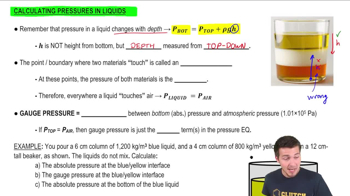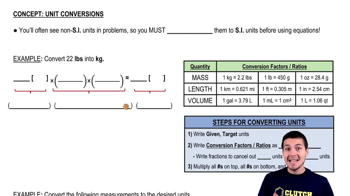Here are the essential concepts you must grasp in order to answer the question correctly.
Hydraulic Systems
Hydraulic systems utilize incompressible fluids to transmit force. According to Pascal's principle, a change in pressure applied to an enclosed fluid is transmitted undiminished throughout the fluid. This principle is fundamental in hydraulic lifts, where a small force applied on a small piston generates a larger force on a larger piston, allowing heavy objects to be lifted with relative ease.
Recommended video:
Pascal's Law and Hydraulic Lift
Pressure Calculation
Pressure is defined as force per unit area, typically measured in pascals (Pa) in the SI system. To calculate the pressure required to lift an object, one must first determine the weight of the object (mass times gravitational acceleration) and then divide this force by the area of the piston. This relationship is crucial for determining the gauge pressure needed in hydraulic systems.
Recommended video:
Calculating Pressure in Liquids
Conversion of Units
In physics, it is often necessary to convert between different units of measurement. For pressure, the conversion from pascals to atmospheres involves knowing that 1 atmosphere is equivalent to 101,325 pascals. Understanding how to perform these conversions is essential for accurately interpreting and communicating results in various contexts, such as engineering and physics problems.
Recommended video:




